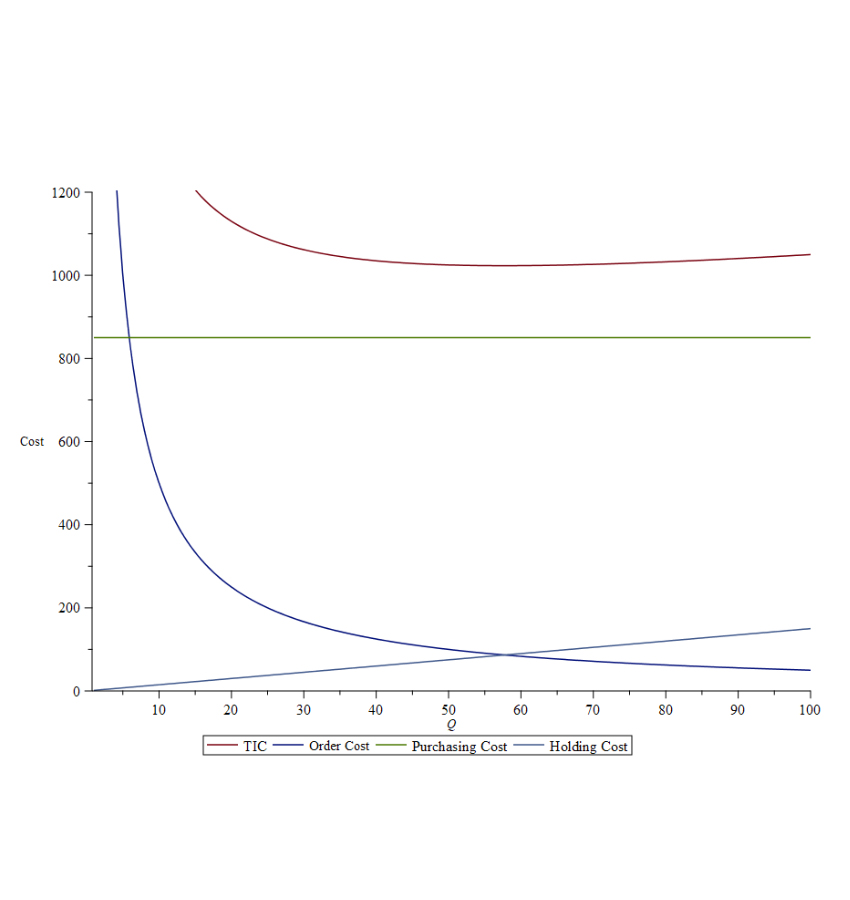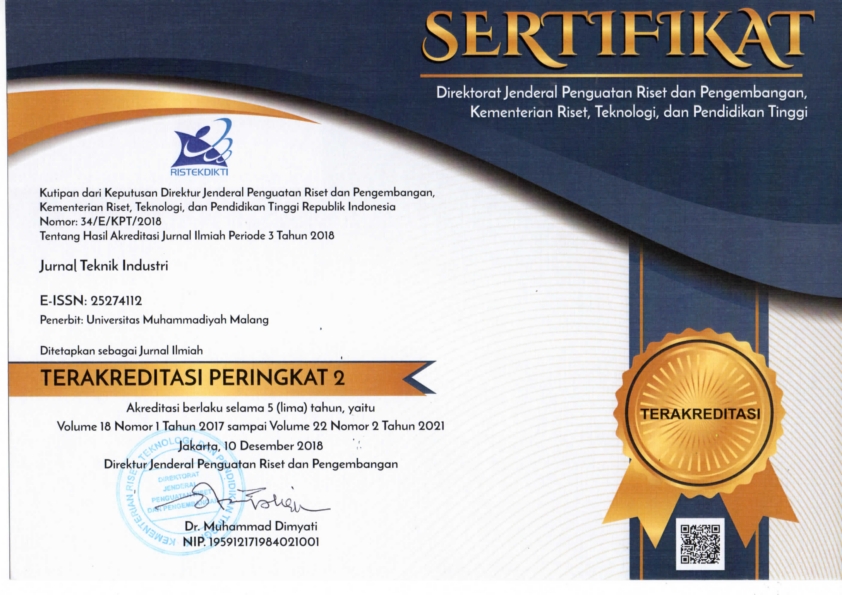The Capacitated Sustainable EOQ Models: Models Considering Tax Emissions
DOI:
https://doi.org/10.22219/JTIUMM.Vol21.No1.12-21Keywords:
Inventory, Lot size, EOQ model, Sustainability, Capital ConstraintsAbstract
The study investigated problems of determining the lot size by considering sustainability and capital constraints for purchasing raw materials and taxes. Using the Sustainable EOQ (SEOQ) models that considered environmental aspects, the researchers also evaluated the capital constraints. The proposed models were used to minimize total inventory costs. In this study, there was a practical numerical analysis and sensitivity analysis to help decision-makers and inventory problems. Finally, the experimental results showed that the proposed models were effectively used to solve the problems.
Downloads
References
[1] D. M. Utama, "Penentuan Lot Size Pemesanan Bahan Baku Dengan Batasan Kapasitas Gudang," Jurnal Ilmiah Teknik Industri, vol. 15, pp. 64-68, 2016. https://doi.org/10.23917/jiti.v15i1.1664.
[2] D. M. Utama, "Model Penentuan Lot Pemesanan Dengan Mempertimbangkan Unit Diskon dan Batasan Kapasitas Gudang dengan Program Dinamis," Jurnal Teknik Industri, vol. 18, p. 9, 2017. https://doi.org/10.22219/JTIUMM.Vol18.No1.94-102.
[3] G. Kim, K. Wu, and E. Huang, "Optimal inventory control in a multi-period newsvendor problem with non-stationary demand," Advanced Engineering Informatics, vol. 29, pp. 139-145, 2015. https://doi.org/10.1016/j.aei.2014.12.002.
[4] D. M. Utama, D. P. Wardani, S. T. Halifah, and D. C. Pradikta, "Model Economic Production Quantity dengan Rework Process dan Batasan Gudang," Jurnal Sistem dan Manajemen Industri, vol. 3, pp. 43-49, 2019. https://doi.org/10.30656/jsmi.v3i1.1017.
[5] P. Hanafizadeh, A. Shahin, and M. Sajadifar, "Robust Wagner–Whitin algorithm with uncertain costs," Journal of Industrial Engineering International, 2018. https://doi.org/10.1007/s40092-018-0298-y.
[6] E. A. Silver, "A Heuristic for Selecting Lot Size Quantities for the Case of a Deterministic Time-Varying Demand Rate and Discrete Opportunities for Replenishment," Prod. Inventory Manage., vol. 2, pp. 64-74, 1973. www.ci.nii.ac.jp/naid/10026018018/en/.
[7] D. M. Utama, "Model Program Dinamis Untuk Lot Size Multi Item Dengan Kendala Kapasitas Gudang," J@ti Undip : Jurnal Teknik Industri, vol. 14, p. 6, 2019. https://doi.org/10.14710/jati.14.1.21-26.
[8] D. M. Utama, "Model Program Dinamis Dalam Penentuan Lot Pemesanan dengan Mempertimbangkan Batasan Modal," in Prosiding SENTRA (Seminar Teknologi dan Rekayasa), 2017, pp. 1-6. www.research-report.umm.ac.id/index.php/sentra/article/view/1463.
[9] D. M. Utama, T. Baroto, D. Maharani, F. R. Jannah, and R. A. Octaria, "Algoritma ant-lion optimizer untuk meminimasi emisi karbon pada penjadwalan flow shop dependent sequence set-up," 2019, vol. 9, pp. 69-78, 2019. https://doi.org/10.24960/jli.v9i1.4775.69-78.
[10] D. M. Utama, "An Effective Hybrid Sine Cosine Algorithm to Minimize Carbon Emission on Flow-shop Scheduling Sequence Dependent Setup," 2019, vol. 20, pp. 62-72, 2019. https://doi.org/10.22219/JTIUMM.Vol20.No1.62-72.
[11] D. M. Utama, "Model EOQ Dengan Mempertimbangkan Karbon Emisi dan Batasan Modal," in Prosiding SENTRA (Seminar Teknologi dan Rekayasa), 2019, pp. 73-78. www.research-report.umm.ac.id/index.php/sentra/article/view/3099.
[12] J. Qin, X. Bai, and L. Xia, "Sustainable Trade credit and replenishment policies under the cap-and-trade and carbon tax regulations," Sustainability, vol. 7, pp. 16340-16361, 2015. https://doi.org/10.3390/su71215818.
[13] H. Yang, J. Luo, and H. Wang, "The role of revenue sharing and first-mover advantage in emission abatement with carbon tax and consumer environmental awareness," International Journal of Production Economics, vol. 193, pp. 691-702, 2017. https://doi.org/10.1016/j.ijpe.2017.08.032.
[14] X. Ma, P. Ji, W. Ho, and C.-H. Yang, "Optimal procurement decision with a carbon tax for the manufacturing industry," Computers & Operations Research, vol. 89, pp. 360-368, 2018. https://doi.org/10.1016/j.cor.2016.02.017.
[15] N. Absi, S. Dauzère-Pérès, S. Kedad-Sidhoum, B. Penz, and C. Rapine, "The single-item green lot-sizing problem with fixed carbon emissions," European Journal of Operational Research, vol. 248, pp. 849-855, 2016. https://doi.org/10.1016/j.ejor.2015.07.052.
[16] V. Hovelaque and L. Bironneau, "The carbon-constrained EOQ model with carbon emission dependent demand," International Journal of Production Economics, vol. 164, pp. 285-291, 2015. https://doi.org/10.1016/j.ijpe.2014.11.022.
[17] S. Tang, W. Wang, H. Yan, and G. Hao, "Low carbon logistics: Reducing shipment frequency to cut carbon emissions," International Journal of Production Economics, vol. 164, pp. 339-350, 2015. https://doi.org/10.1016/j.ijpe.2014.12.008.
[18] A. A. Taleizadeh, V. R. Soleymanfar, and K. Govindan, "Sustainable economic production quantity models for inventory systems with shortage," Journal of cleaner production, vol. 174, pp. 1011-1020, 2018. https://doi.org/10.1016/j.jclepro.2017.10.222.
[19] D. Battini, A. Persona, and F. Sgarbossa, "A sustainable EOQ model: theoretical formulation and applications," International Journal of Production Economics, vol. 149, pp. 145-153, 2014. https://doi.org/10.1016/j.ijpe.2013.06.026.
[20] X. Chen, S. Benjaafar, and A. Elomri, "The carbon-constrained EOQ," Operations Research Letters, vol. 41, pp. 172-179, 2013. https://doi.org/10.1016/j.orl.2012.12.003.
[21] M. Y. Jaber, M. Bonney, and H. Jawad, "Comparison between economic order/manufacture quantity and just-in-time models from a thermodynamics point of view," Computers & Industrial Engineering, vol. 112, pp. 503-510, 2017. https://doi.org/10.1016/j.cie.2016.08.023.
[22] P. He, W. Zhang, X. Xu, and Y. Bian, "Production lot-sizing and carbon emissions under cap-and-trade and carbon tax regulations," Journal of Cleaner Production, vol. 103, pp. 241-248, 2015. https://doi.org/10.1016/j.jclepro.2014.08.102.
[23] H. Liao and Q. Deng, "A carbon-constrained EOQ model with uncertain demand for remanufactured products," Journal of Cleaner Production, vol. 199, pp. 334-347, 2018. https://doi.org/10.1016/j.jclepro.2018.07.108.
[24] A. Gurtu, M. Y. Jaber, and C. Searcy, "Impact of fuel price and emissions on inventory policies," Applied Mathematical Modelling, vol. 39, pp. 1202-1216, 2015. https://doi.org/10.1016/j.apm.2014.08.001.
[25] J. Bauer, T. Bektaş, and T. G. Crainic, "Minimizing greenhouse gas emissions in intermodal freight transport: an application to rail service design," Journal of the Operational Research Society, vol. 61, pp. 530-542, 2010. https://doi.org/10.1057/jors.2009.102.
[26] M. C. Arslan and M. Turkay, "EOQ revisited with sustainability considerations," Foundations of Computing and Decision Sciences, vol. 38, pp. 223-249, 2013. https://doi.org/10.2478/fcds-2013-0011.
[27] M. Bonney and M. Y. Jaber, "Environmentally responsible inventory models: Non-classical models for a non-classical era," International Journal of Production Economics, vol. 133, pp. 43-53, 2011. https://doi.org/10.1016/j.ijpe.2009.10.033.
[28] D.-H. Lee, M. Dong, and W. Bian, "The design of sustainable logistics network under uncertainty," International Journal of Production Economics, vol. 128, pp. 159-166, 2010. https://doi.org/10.1016/j.ijpe.2010.06.009.
[29] P. Letmathe and N. Balakrishnan, "Environmental considerations on the optimal product mix," European Journal of Operational Research, vol. 167, pp. 398-412, 2005. https://doi.org/10.1016/j.ejor.2004.04.025.
[30] T. Penkuhn, T. Spengler, H. Püchert, and O. Rentz, "Environmental integrated production planning for the ammonia synthesis," European Journal of Operational Research, vol. 97, pp. 327-336, 1997. https://doi.org/10.1016/S0377-2217(96)00201-9.
[31] J. Q. F. Neto, J. M. Bloemhof-Ruwaard, J. A. van Nunen, and E. van Heck, "Designing and evaluating sustainable logistics networks," International Journal of Production Economics, vol. 111, pp. 195-208, 2008. https://doi.org/10.1016/j.ijpe.2006.10.014.
[32] N. Kim, M. Janic, and B. Van Wee, "Trade-off between carbon dioxide emissions and logistics costs based on multiobjective optimization," Transportation Research Record: Journal of the Transportation Research Board, pp. 107-116, 2009. https://doi.org/10.3141/2139-13.
[33] A. Raturi and V. R. Singhal, "Estimating the opportunity cost of capital for inventory investments," vol. 18, pp. 407-413, 1990. https://doi.org/10.1016/0305-0483(90)90031-4.
[34] M. R. Asadabadi, "A Revision on Cost Elements of the EOQ Model," Studies in Business and Economics, vol. 11, pp. 5-14, 2016. https://doi.org/10.1515/sbe-2016-0001.

Downloads
Published
How to Cite
Issue
Section
License
Copyright (c) 2020 Sri Kurnia Dwi Budi Maulana, Dana Marsetiya Utama, Mochammad Samsul Asrofi, Inggit Sekar Ningrum, Nidaul Alba, Hikam Antasyard Ahfa, Thoriq Akbar Zein

This work is licensed under a Creative Commons Attribution-ShareAlike 4.0 International License.











